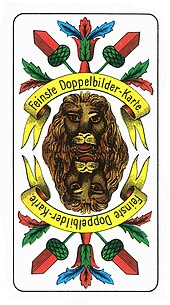



The deuce (German: Daus, plural: Däuser) is the playing card with the highest value in German card games. It may have derived its name from dice games in which the face of the die with two pips is also called a Daus in German.[1]
Unlike the ace, with which it may be confused, the deuce represents the 2, which is why two hearts, bells, etc. are depicted on the card. In many regions it is not only equated to the ace, but is also, incorrectly, called an ace. In the south German area it has been historically called the sow (Sau) and still is today,[1] because of the appearance of a wild boar on the deuces in early card packs, a custom that has survived on the deuce of bells.
Ei der Daus! (also: Was der Daus!) is an expression, similar, to "What the deuce!" in English, which reflects astonishment, bewilderment or even anger. It is commonly, if wrongly, assumed to be an expression derived from card players' jargon.[2]
In some games outside Germany, the Deuce may rank higher than the Ace, such as in Big two, Tiến lên, and President (card game). These games share a common ancestor, the Chinese game of Zheng Shangyou.[citation needed] This ranking system may be influenced by Chinese numerology, where the two is seen as an auspicious number.
- ^ a b Games played with German suited cards at www.pagat.com. Retrieved 26 May 2018.
- ^ Lutz Röhrich: Lexikon der sprichwörtlichen Redensarten, 5 volume, Freiburg i. Br. 1991; Lemma Daus in Vol. 1, p. 309